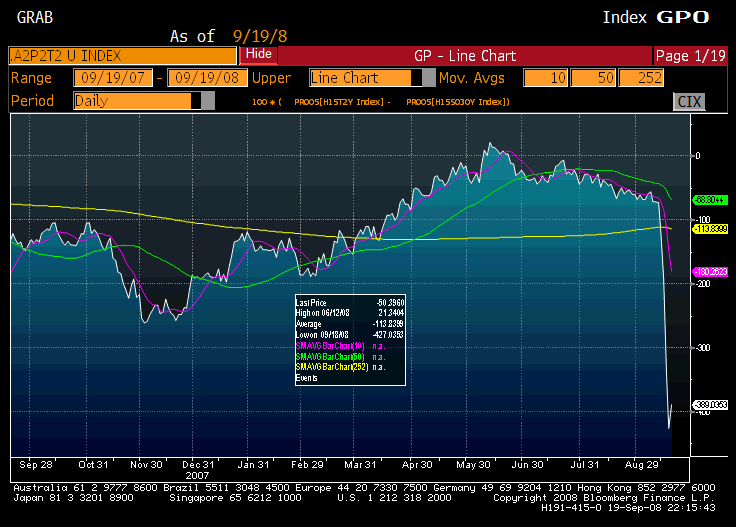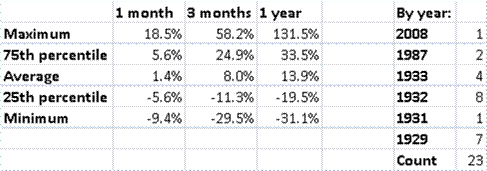I want to update my two Thursday evening pieces.? First with respect to Liquidity for the Government and no Liquidity for Anyone Else, the degree of financial stress in the short-term part of the market is worse.? Here’s the graph:
Much as the government wants to eliminate stress in the lending markets, I don’t think they are succeeding.? The little bounce still leaves the indicator below Thursday’s close.
One reader brought up the timing mismatch in this indicator, because I have a 2-year Treasury versus a 90-day commercial paper series.? I use the 2-year Treasury, because it is very sensitive to changes in expectations for short-term interest rates.? I suppose I could use 3-month T-bills to match, but this indicator arose out of comparing two different series that change in opposite directions when the economy strengthens or weakens.
Part 2
Now for my article Now We?re Talking Volatility.? Okay, so we had three 4% moves in a five business day period, well, now you have four of them.? Now how do the statistics look?
Oddly, after four 4% events in five days the average return is lower than that for three 4% days.? Most of the history here comes from the Great Depression, and we are dealing with the “Law of Small Numbers” here, so I am not inclined to offer definitive analysis here.? I will give you my guess, though.? Extreme volatility often begets an opportunity for profit, but also sometimes begets significant future losses.? I lean toward the profit side here in the short run, but I also realize that the actions of the US Government might not be the best for the markets, even if the markets have interpreted it positively in the short run.
I would be neutral-to-positive on the US equity market here.? The presidential cycle is a positive, as is the current market volatility.? Given the difficulties with financials, I can’t get very positive, though.? Play defense, wherever you are.



Hi David,
Thanks for the update.
Steve
I remain shocked as to how many investors I otherwise have tremendous respect for place so much credibility in the presidential cycle. David hasn’t indicated any great allegiance, but people like Jim Stack and Jeremy Grantham have. Why not use the weather?
There is certainly a tendency for politicians to game money supply to try to assure re-election, but a belief in their omnipotent ability to accomplish this is where I find fault in the presidential cycle.
I fell victim to this kind of analysis in early 2001 when the Fed cut rates again. All the historical numbers showed that the stock market “never” went down after x number of rate cuts…yada yada yada…and 18 months later the market was significantly lower.
There is no question that the poles will TRY to juice things and they surely have played almost all of there cards already. What if it doesn’t work this time? How big could the capitulation be if such a major rescue effort doesn’t support the markets?
The reality is that these bailouts will do little to help stave off the major problems over the next 6-12 months. We are in recession and it is getting worse and may be turning global. House prices are not stabilizing – ECRI’s leading index is still heading down! Given that backdrop, I would say that gambling on the presidential cycle or the government’s ability to pull a rabbit out of their hat is extremely aggressive!
as always excellent work; Hang in there everybody!!!
Mr. Merkel, don’t you think with all of the politics going around the election that this could be causing more politicized decisions around what’s happening in the markets (as opposed to logical financial thinking)?
I parsed that same data over the weekend and came to the opposite conclusion: while there may be a limited short-term upside, this has a very high potential to get much worse.
The data show clearly that very high two-way volatility incidents (4 out of 5 days moving by more than 4%) only occur very rarely. Further, the macro picture is quite grim, with a real estate collapse, banks buried in bad loans, and a general unwillingness to lend due to a lack of accounting transparency.
The 1987 volatility incident suggests that we might rebound soon. If so, there will be plenty of time to get on that train; corporate profits are very unlikely to return to “Dow 14000” levels within 3-6 months.
The 1929-1933 incidents suggest that we *might* see a vicious circle leading to a 75% decline. There is much less time to get out of a crashing bear-market train than to get onto a bull train leaving the station. And unfortunately I’m no longer optimistic about this government’s ability to prevent such a calamity.
In my opinion the risks outweigh the likely immediate returns.
Wow, we almost made it 5 out of 7 days – the S&P closed down 3.82%, only missed it by 18 bps!
What a wild market.